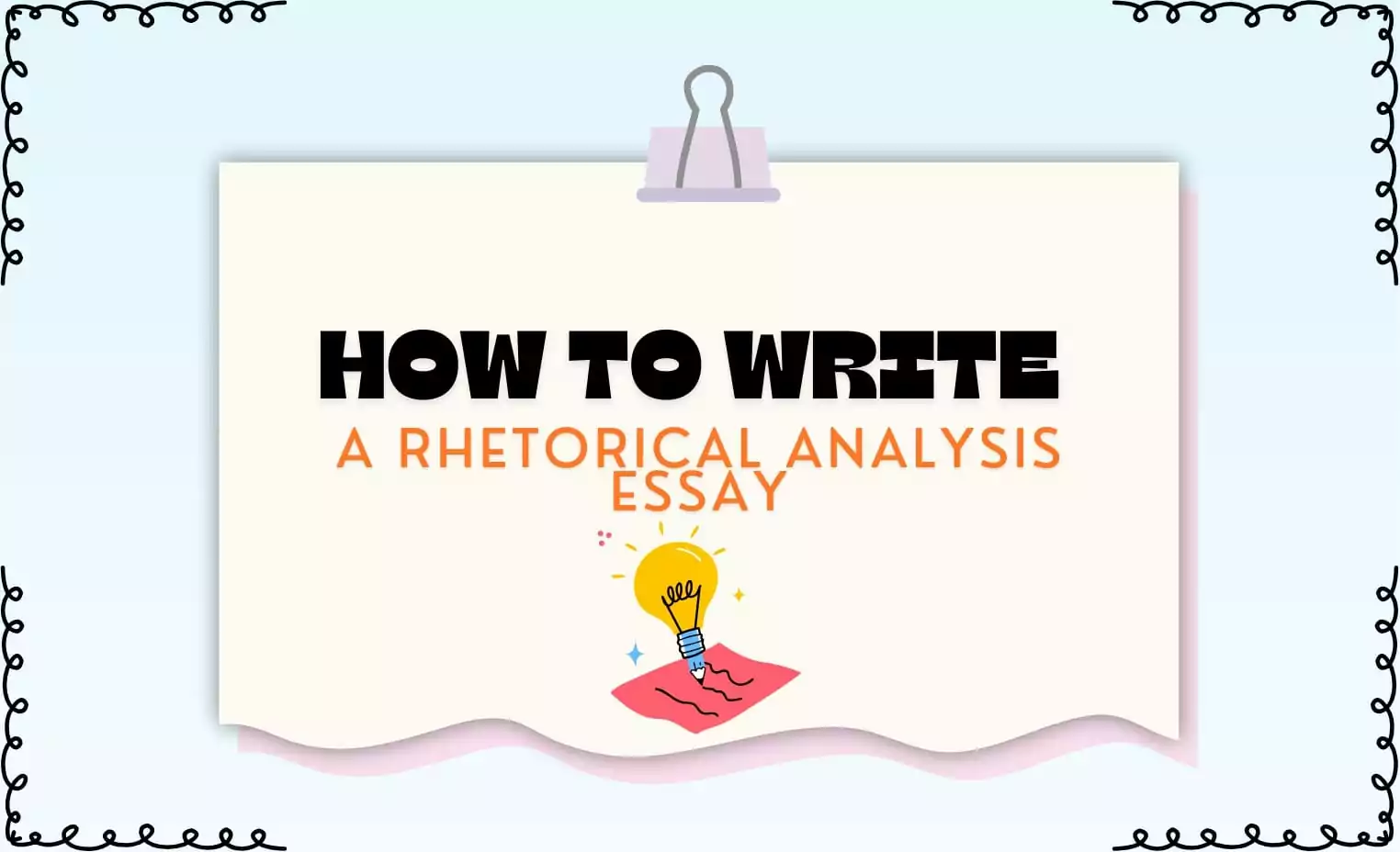How to Write a Rhetorical Analysis Essay

Have you ever read a book that had such a unique writing style that you wanted to look more into how it’s written and what the author was trying to achieve through such a style? If that happened to you, then you could satisfy your interest by writing a rhetorical analysis essay. This type of paper is specifically dedicated to the analysis of words, sentence structure, and other linguistic aspects and how these structures are used to influence the reading audience through the text. Thus, if you are interested in doing such a rhetoric breakdown of your favorite (or even least liked) books, continue reading. The article below will provide you with everything you need to know about crafting such essays and give you a rhetorical essay example to follow.
Rhetorics & Rhetorical Writing: What is It and How to Recognize It?
Rhetoric, in its simplest form, is the art of persuasive communication, whether through writing or speech. At the heart of rhetoric are three essential concepts: logos, ethos, and pathos, which together create a framework for understanding how language can be used to influence an audience.
- Logos refers to the logical appeal in rhetoric. This is where reason, evidence, and facts come into play. Imagine reading an academic essay filled with charts, statistics, and well-structured arguments. The intention here is to convince you through the sheer weight of rational evidence, making the case nearly impossible to refute.
- Ethos is the ethical appeal, which basically reflects the credibility of the speaker or writer. For example, when a medical doctor writes an article about health, their expertise and credentials lend significant weight to their arguments. The audience is more likely to trust their insights because of the authority they bring to the subject.
- Pathos is the emotional appeal that aims to elicit a specific feeling from the audience. Think of a commercial that shows a happy family enjoying a product. Of course, it is selling the product, but it is selling the emotional experience associated with it as well. By tapping into your emotions, the rhetoric seeks to create a deeper connection and persuade you on a more personal level.
Rhetorical writing, therefore, is characterized by the strategic use of these appeals to sway an audience. The main tools aren’t the words themselves but how they are being said. This style of writing carefully considers tone, diction, and overall structure to maximize its persuasive power.
Thus, to recognize rhetorical writing, you need to look beyond the surface of the text (the content) and analyze how these elements work together to persuade. Consider the context—who wrote it, when, and why. Pay attention to how the author builds credibility (ethos), presents logical arguments (logos), and plays on emotions (pathos). For instance, in a charity campaign, the organization might showcase the expertise of their team members to establish credibility (ethos), present statistics on the impact of donations to provide logical support (logos) and share heartwarming stories of lives changed by contributions to evoke an emotional response from potential donors (pathos).
Creating a Rhetorical Analysis Essay Outline
So, before you start writing your essay with our Essay Generator, it is a good thing to create an outline for it first. Why, you may ask? Well, when writing a rhetorical analysis essay, having a well-organized structure helps make sure your essay flows logically and covers all the important points of the matter. Let’s look a little bit closer at how you can create a useful outline for your paper.
1. Introduction
The introduction is where you set the stage for your analysis. Start by naming the text you’ll be analyzing—mention the author, the title, and a summary of the work. Then, provide some context, explaining the purpose of the text and its intended audience. Conclude the introduction with your thesis statement, where you briefly outline the main points you’ll be analyzing. This thesis should hint at the rhetorical strategies used by the author, such as their use of logos, ethos, or pathos.
2. Body Paragraphs
The body of your essay is where you carry out the detailed analysis of the rhetorical strategies. A typical approach is to dedicate one paragraph to each of the main rhetorical elements or another organizing principle that makes sense for your analysis.
- Paragraph 1: Analysis of Logos (Logical Appeal)
- Start by identifying the logical arguments presented by the author.
- Discuss how the author uses evidence, facts, statistics, or reasoning to support their argument.
- Provide examples from the text and explain how these contribute to the overall persuasiveness of the work.
- Paragraph 2: Analysis of Ethos (Ethical Appeal)
- Discuss how the author establishes their credibility or authority on the subject.
- Examine the tone, language, and any references to the author’s expertise or character.
- Use examples from the text to demonstrate how ethos is used to build trust with the audience.
- Paragraph 3: Analysis of Pathos (Emotional Appeal)
- Explore how the author appeals to the audience’s emotions.
- Identify any emotional language, vivid imagery, or anecdotes that aim to provoke an emotional response.
- Analyze how these emotional appeals contribute to the overall effectiveness of the argument.
3. Conclusion
In the conclusion, summarize your analysis and restate the thesis in light of the discussion you’ve just had. Highlight the key rhetorical strategies and reflect on their overall effectiveness. Consider ending with a final thought on the significance of the rhetorical choices made by the author and how they contribute to the text’s impact on its audience.
Example of a Well-Structured Outline

A Detailed Guide on How to Write a Rhetorical Analysis
Now, we can move on to the writing process. Don’t be scared and try not to get too overwhelmed. There’s nothing that hard in the process, especially if you break it down into manageable steps. This guide will provide you with a step-by-step breakdown of the process, along with practical advice and examples to help you write a high-quality essay.
Step 1: Choose and Study the Text
The first step in writing a rhetorical analysis essay is selecting the text you want to analyze. This could be a speech, an essay, an advertisement, or even a visual content like a political cartoon. Choose a text that interests you or relates to a topic you’re passionate about, as this will make the analysis process more engaging.
Once you’ve chosen your text, read it thoroughly—multiple times, if necessary. Your goal is to become familiar with the author’s argument, style, and the context in which the text was created. If we take the analysis of J.D. Salinger’s The Catcher in the Rye as an example, here close attention needs to be paid to the narrative style, themes of alienation, and the historical context of post-war America.
Step 2: Gather Information Using the SOAPSTone Technique
To deepen your understanding of the text, use the SOAPSTone technique to gather key information:
- Speaker: Identify who is delivering the message. In The Catcher in the Rye, the speaker is Holden Caulfield, a disillusioned teenager.
- Occasion: Consider the context or situation that prompted the text. The novel is set in post-war America, reflecting the cultural and societal changes of the time.
- Audience: Determine who the intended audience is. Salinger’s novel was initially targeted at adult readers, but it resonated with younger audiences as well.
- Purpose: Understand the author’s purpose. In this case, Salinger aimed to explore themes of innocence, identity, and rebellion.
- Subject: Identify the main subject of the text. The novel discusses the complexities of adolescence and the struggle against societal expectations.
- Tone: Analyze the tone of the text. Holden’s tone is often sarcastic, cynical, and reflective, which adds depth to the narrative.
Step 3: Identify the Rhetorical Appeals (Ethos, Pathos, Logos)
Next, examine how the author uses rhetorical appeals to persuade their audience:
- Ethos (Credibility): Consider how the author establishes credibility. In The Catcher in the Rye, Salinger uses Holden’s first-person narrative to create an authentic voice that resonates with readers.
- Pathos (Emotional Appeal): Look at how the text appeals to the reader’s emotions. Holden’s feelings of loneliness and alienation evoke empathy, making the novel emotionally compelling.
- Logos (Logical Appeal): Analyze how the author uses logic and reasoning. Although The Catcher in the Rye is more emotionally driven, Salinger logically structures Holden’s experiences to highlight the inconsistencies and hypocrisy in society.
Step 4: Analyze the Style Choices
After identifying the rhetorical appeals, focus on the author’s choices in terms of style, such as word choice, repetition, and imagery.
Diction.
Examine the author’s word choice. Salinger’s use of colloquial language and slang in Holden’s speech reflects the character’s age and rebellious nature.
Repetition.
Look for repeated phrases or ideas. Holden frequently uses phrases like “phony” to emphasize his disdain for adult hypocrisy.
Imagery
Consider how the author uses imagery to improve the text. The recurring motif of the red hunting hat symbolizes Holden’s desire to protect his individuality.
Step 5: Build Your Analysis
With your gathered information, start building your analysis by asking key questions:
- What is the author’s intention?
- How do the rhetorical strategies contribute to the overall purpose of the text?
- What effect does the text have on its audience?
Example: In The Catcher in the Rye, Salinger’s intention may be to critique the superficiality of society and to explore the challenges of adolescence. The combination of Holden’s credibility, the emotional resonance of his experiences, and the logical critique of societal norms all work together to achieve this purpose.
Step 6: Write the Introduction
Begin your essay with a clear introduction that provides background on the text and its author. Briefly summarize the text, including its purpose, audience, and context. Then, present your thesis statement, which should outline the main points of your analysis.
Example: In J.D. Salinger’s The Catcher in the Rye, the story is told from the perspective of Holden Caulfield, a teenager who’s struggling with feelings of alienation and identity in the aftermath of World War II. Salinger uses this first-person narrative to dig into Holden’s experiences and critique the societal norms of the time. By blending main rhetorical strategies like ethos, pathos, and logos, Salinger effectively highlights the challenges of adolescence and the pressures of fitting into a world that often feels phony.
Step 7: Construct the Body Paragraphs
Use the body paragraphs to support your thesis with detailed analysis. Each paragraph should focus on a different rhetorical strategy or element of the text:
- Paragraph 1: Analyze the use of ethos by discussing Holden’s credibility and how it influences the reader’s perception.
- Paragraph 2: Explore the emotional appeal (pathos) in Holden’s experiences and how they resonate with the audience.
- Paragraph 3: Examine the logical appeal (logos) and how Salinger structures the narrative to critique society.
Support each point with specific examples from the text, such as quotes or passages that illustrate the rhetorical strategies in action.

Step 8: Pay Attention to Language
As you write, pay close attention to the language used in the text and use the style analysis you did in step 4. Try to answer the following questions:
- How does the author’s diction (word choice) contribute to the tone and effectiveness of the text?
- Does the author use literary devices, such as metaphors or symbolism, to enhance their message?
- How do these elements support the author’s overall purpose?
For example, Salinger’s use of colloquial language and repetition in Holden’s dialogue emphasizes his disconnection from the adult world and reinforces the novel’s themes.
Step 9: Write the Conclusion
In conclusion, restate your thesis and summarize the key points of your analysis. Discuss the overall impact of the rhetorical strategies used in the text and reflect on the significance of the author’s choices.
Example:
In conclusion, J.D. Salinger’s The Catcher in the Rye masterfully uses ethos, pathos, and logos to create a poignant critique of society and a deep exploration of adolescent identity. Through Holden Caulfield’s authentic voice and emotionally charged experiences, Salinger connects with readers on a personal level, making the novel a timeless reflection on the challenges of growing up.
Step 10: Review and Revise
Finally, review your essay for clarity, coherence, and completeness. Make sure that your analysis is well-supported by evidence from the text and that your writing is free of errors. Revising your work is an important step so don’t skip it. This way you can be sure that your rhetorical analysis is polished and effective.
FAQ
What are the 3 main parts of a rhetorical analysis?
The three main parts of a rhetorical analysis are the introduction, body, and conclusion. In the introduction, you’ll start by introducing the text and giving some background information, along with a thesis statement that highlights your main points. The body is where you get into the details, analyzing how the author uses rhetorical strategies like ethos, pathos, and logos to persuade their audience. Finally, the conclusion wraps it all up by summarizing your analysis and reflecting on how effective the author’s approach is.
What are the 5 elements of a rhetorical analysis?
When you’re conducting a rhetorical analysis, it’s important to consider five key elements: the speaker, the occasion, the audience, the purpose, and the tone. The speaker refers to who is delivering the message, while the occasion looks at the context or situation in which the text was created. Understanding the intended audience helps you see who the text is trying to reach, and knowing the author’s purpose gives insight into their goals. Finally, the tone reveals the overall attitude or feeling conveyed by the text. These elements guide you in understanding and analyzing the text more deeply
What are some examples of rhetorical analysis?
Examples of rhetorical analysis can range from examining a famous speech like Martin Luther King Jr.’s “I Have a Dream,” where you might explore how he uses emotional appeals and powerful imagery to inspire and persuade, to analyzing an advertisement that combines emotional appeal, expert endorsements, and facts or statistics to convince you to buy a product. You could also look at a novel like To Kill a Mockingbird exploring how the author’s narrative style and character development convey deeper themes. Each of these examples explores how various rhetorical strategies are used in different contexts to influence the audience.
What are the 4 steps to making a rhetorical analysis?
To make a rhetorical analysis, you first need to thoroughly read and understand the text to grasp its meaning and purpose. After that, you should identify the rhetorical strategies used, such as ethos for credibility, pathos for emotional appeal, and logos for logical argument. Once you’ve identified these, the next step is to analyze how they are used and how they contribute to the text’s influence. Finally, you’ll write your analysis, organizing your findings into an essay with a clear introduction, detailed body paragraphs, and a strong conclusion that ties everything together.





